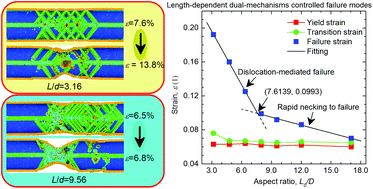Length-dependent dual-mechanism-controlled failure modes in silver penta-twinned nanowires†
Abstract
A series of molecular dynamics simulations on silver penta-twinned nanowires are performed to reveal the tensile failure mechanisms that are responsible for the different failure modes and morphologies of fracture surfaces observed in various experimental reports. The simulations show that a ductile-to-brittle transition in failure mode occurs with increasing length of the nanowires. Short nanowires have ductile-like plasticity with flat-like fracture surfaces, while long nanowires show brittle-like fractures with cone-like failure surfaces. These two seemingly counterintuitive scenarios can be attributed to two sets of mechanisms: (1) stable dislocation nucleation-controlled incipient plasticity followed by stable dislocation motion-mediated plasticity assisted by pores for short nanowires, (2) unstable dislocation nucleation-controlled incipient plasticity followed by rapid necking for long nanowires. These two sets of failure mechanisms are distinguished by fitted lines using phased strain data. We propose a general strategy to build a necking-based model for predicting the critical nanowire aspect ratio while distinguishing the fracture modes. A mechanism map of silver penta-twinned nanowire is constructed to delineate the predominant failure behaviours. Our findings reveal a correlation between the failure mode and the resulting morphology of the fracture surface and provide a paradigm for the design and engineering of mechanical properties of nanowires.



 Please wait while we load your content...
Please wait while we load your content...